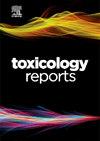Pharmacogenetic exploration of buprenorphine and related metabolites in umbilical cord blood
Q1 Environmental Science
引用次数: 0
Abstract
The goal of this study was to explore associations between single-nucleotide polymorphisms (SNPs) and umbilical cord blood concentrations of buprenorphine and its metabolites following maternal administration. This is a sub-study of a prospective observational cohort investigation which included pregnant women receiving buprenorphine for opioid use disorder during pregnancy. Following delivery, umbilical cord blood samples were collected and genotyped using a pharmacogenetic panel. The drug and metabolite concentrations were analyzed through liquid chromatography-mass spectrometry, and genetic association analysis was completed using PLINK software. The included neonates (n = 14) had a mean birth weight of 3.00 ± 0.39 kg and were born to mothers receiving a mean buprenorphine dose of 10.29 ± 6.22 mg. Ten concentration groupings (drug, single metabolite, as well as drug/metabolite(s) combinations) produced 18 unique SNP associations. Two significant associations included variations in CYP3A4 and UGT1A1, which play a role in the metabolism of buprenorphine. These preliminary findings suggest potential pharmacogenetic factors influencing fetal drug exposure, warranting larger studies to validate associations and explore clinical implications for neonatal outcomes.
脐带血丁丙诺啡及其相关代谢物的药理学研究
本研究的目的是探讨单核苷酸多态性(snp)与母亲给药后丁丙诺啡及其代谢物的脐带血浓度之间的关系。这是一项前瞻性观察队列研究的子研究,该研究包括在怀孕期间接受丁丙诺啡治疗阿片类药物使用障碍的孕妇。分娩后,采集脐带血样本,并使用药物遗传学小组进行基因分型。采用液相色谱-质谱联用分析药物及代谢物浓度,采用PLINK软件进行遗传关联分析。纳入的新生儿(n = 14)平均出生体重为3.00 ± 0.39 kg,其母亲的丁丙诺啡平均剂量为10.29 ± 6.22 mg。10个浓度分组(药物、单一代谢物以及药物/代谢物组合)产生了18个独特的SNP关联。两个重要的关联包括CYP3A4和UGT1A1的变异,它们在丁丙诺啡的代谢中起作用。这些初步发现表明,潜在的药物遗传因素影响胎儿药物暴露,需要更大规模的研究来验证相关性,并探索新生儿结局的临床意义。
本文章由计算机程序翻译,如有差异,请以英文原文为准。
求助全文
约1分钟内获得全文
求助全文
来源期刊

Toxicology Reports
Environmental Science-Health, Toxicology and Mutagenesis
CiteScore
7.60
自引率
0.00%
发文量
228
审稿时长
11 weeks
 求助内容:
求助内容: 应助结果提醒方式:
应助结果提醒方式:


